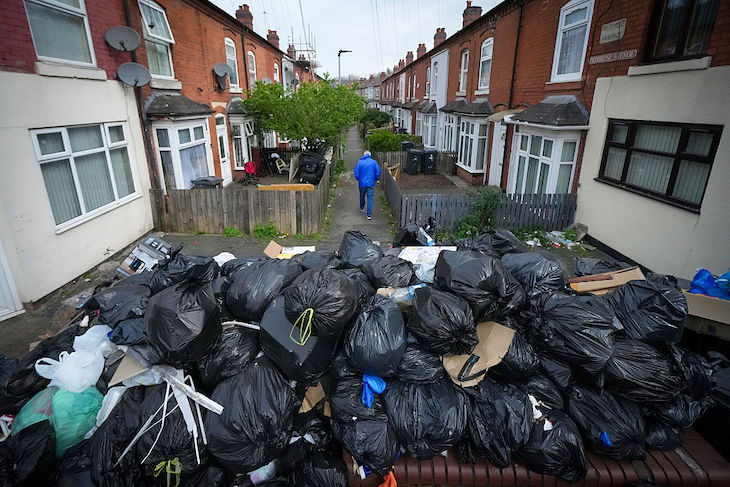As the Birmingham binmen’s strike, full on since 11 March, grinds well into its second month, there is talk of similar action spreading nationwide. A crop of lurid headlines have been appearing in the press: ‘My Mercedes was destroyed by rats’, exclaims the Daily Telegraph, while the Daily Star announces that ‘Psycho seagulls and super rats team up to spread disease in Birmingham trash mountains.’ Residents, meanwhile, have begun to complain about marauding urban foxes, and of infestations of cockroaches and ‘rats as big as cats.’ With Deputy Prime Minister Angela Rayner calling in the army to help with the crisis, there is, as so often with Keir Starmer’s government, a sense of déjà vu: such scenes recall the darkest days of the 1970s.
The crisis was not – Rayner and co. may take heart – exclusively a Labour phenomenon. In Autumn 1970, under Edward Heath’s newly elected Conservatives, 60,000 refuse and sewage workers went on a two-month strike, with calamitous results. As in Labour’s ‘Winter of Discontent’ eight years later, uncollected rubbish bags, a great Pennine of them, began to rear up in Leicester Square. In Tower Hamlets, troops were brought in to clear the streets of rotting offal, while in Whitehall – in the lead-up to Remembrance Day – a more genteel solution was found. A group of ‘six patriots’ (among them the daughter of the Duke of St Albans) volunteered to sweep the streets, in an act described by their leader as ‘a demonstration against industrial anarchy.’ As the decade progressed, it was clear such demonstrations hadn’t worked.
In Glasgow, 1975, under the Wilson Labour government, it was the same story. During a binmen’s strike that lasted more than three months, around 50,000 tons of uncollected rubbish began to accumulate in mounds 20 feet high. One Glasgow mother, complaining of the unbearable, putrid stench over the city, spoke too of ‘rats starting to get into our houses,’ and ‘even the flies…going mad.’ When troops were brought in by Wilson to deal with it, there were reports of them battling with swarms of feral rodents and even ‘holding their defeated opponent up for cameras to film.’
But many in the seventies could imagine the rats, not the soldiers, winning the battle. ‘At the moment,’ said an environmental health specialist at London University, ‘We are retreating, and the rats are advancing.’ They were certainly, at any rate, beginning to infest popular culture. Both the New Avengers episode ‘Gnaws’ and Doctor Who’s ‘The Talons of Weng Chiang’ showed giant, killer rodents terrorising the city.
Rock music had paid attention too, David Bowie (historian Alwyn Turner points out) singing on his 1974 album Diamond Dogs of ‘fleas the size of rats’ which ‘sucked on rats the size of cats,’ while in 1977 the Stranglers released their platinum-selling album Rattus Norvegicus. But it was James Herbert, in his bestselling 1974 novel The Rats, who seemed to key most deeply into people’s fears. Set in a contemporary London, it showed a scurrying plague of vicious rodents, ‘big as dogs’ and with ‘sharp, wicked-looking eyes’ taking over the capital, spreading fatal disease and feasting on live human flesh. A group of tramps, a year-old baby, a pest-control expert and plenty of others are all dispatched in graphic, gory detail. A typical passage, as one homeless alcoholic meets her end, runs as follows:
Her back arched as her nerve-ends tautened and she fell forward again. Another rat pulled at her ear. Suddenly, her whole body was covered, teeming with squealing creatures as more scurried from the darkness, the smell of blood much stronger than it had been before… The rats drained her body of blood and gnawed her flesh until not much more than bones and pieces of skin remained. It didn’t take long, for there were many of them. So many, that not all had been fully gorged. Their hunger for human flesh had been merely inflamed — they wanted more.
Both the pests and the piled up, scattered refuse were back in 1978 with a vengeance under Labour’s Jim Callaghan. During the ‘Winter of Discontent,’ essential workers in electricity, road haulage, transport, health, gravedigging and – yes – sanitation, all came out on strike. In Westminster alone, the council was forced to open thirty impromptu open-air rubbish tips to cope with the catastrophe. Once again, Leicester Square – renamed ‘Fester Square’ by the popular press – became the most visible dumping ground, though other areas of Central London weren’t left unscathed. Actor and diarist Michael Palin spoke of ‘piles of uncollected rubbish…being blown apart by the wind,’ and of a West End like ‘a tip from which buildings emerge.’
Similar townscapes were visible in Cardiff, Bristol and Plymouth. On Winchester’s Stanmore housing estate, one contributor to the BBC ‘Your 1970s’ website recalls, ‘the piles of garbage piled up in our local recreation ground…The piles of rotten waste became our playground…I was lucky enough to find a whole bag of used syringes!’ Auberon Waugh, in this publication, described (with comic hysteria) the UK descending into a full-on dystopia, where ‘rubbish lies uncollected on the street, old-age pensioners are mercilessly raped whenever they venture out after dark, dying like flies in any case and their corpses left unburied.’ Though authorities put down rat poison, journalists found refuse-bags ‘dripping with food scraps and loose rubbish.’ The rodents were back.
Naturally, Labour’s opponents leapt on it. ‘The phrase “law and order,”’ said opposition leader Margaret Thatcher, ‘does not refer only to vandalism and violence – although that is uppermost in many people’s minds. It means that our citizens expect and are not getting an ordered or orderly society. They expect the rubbish to be cleared, the schools to be open and the hospitals to be functioning. They are not.’ Historian Dominic Sandbrook partly blames the binmen’s strike for ending hopes of Scottish devolution that year: ‘As rubbish mounted in the streets and the government’s popularity went into free fall, traditional Labour supporters lost interest in the cause.’
But, as Sandbrook also points out, it was Callaghan aide Bernard Donoughue, writing of the 1979 election in his diaries, who brought home the catastrophic impact of such scenes for Labour. Visiting a local polling station, Donoughue saw ‘just a trickle of old ladies. I could tell from the determined look in their eyes that they had not come to vote FOR anybody. They had come to vote AGAINST […] every trade union thug who stood in a picket line barring the way to the hospital or the graveyard that they feared might be their destination tomorrow. And against every Labour local authority which had left piles of rubbish in the way of their shopping.’ Labour, trounced by Mrs Thatcher’s Conservatives, would be out of power for 18 years.
‘We lost the election,’ Callaghan said to Tony Benn, ‘because people didn’t get their dustbins emptied, because commuters were angry about train disruption and because of too much union power.’ They are words the Starmer government should ponder long and hard in the next four years – lest those tottering mounds of rubbish, the bewildered, angry residents and those flocks of ‘psycho seagulls’ should prove, in time, a mere foretaste of things to come.







Comments